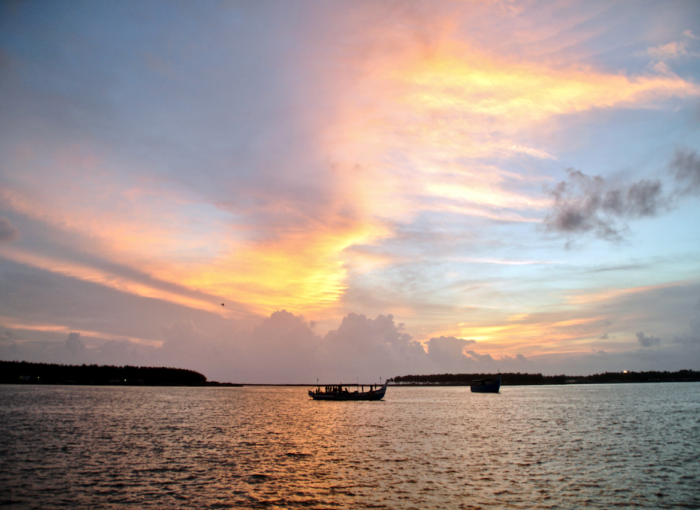Nila, is more than a just a river to the people of Kerala. Bharathapuzha, as she is fondly called, is treated with the same respect and status of river Ganga in Kerala. Poets termed her the mother of the Malayalam Culture. Over the centuries, she fostered and shaped the Malayalam literature, traditions, and folk arts. She had witnessed the social and cultural renaissance, prosperity and war. Within her ebb and flow, she nurtured the spirit and soul of the land. She was called Shokanashini ( Destroyer of Sorrow) and Kannerpuzha ( River of Tears) at the same time. Her history is deeply intertwined with the History of the land, Kerala.
Nila Trail
Bharatapuzha originates From the ‘Aanamalai Hills’, and gathers the spirit of Gayathripuzha, Thuthapuzha, and Kannadipuzha en route and Joins Arabian Sea at Ponnani in Malappuram District.
From childhood itself, the books and fables had created an emotional attachment to Nila in my mind. Later in the early part of my professional career, i had crossed her several times at Ottappalam and Cheruthuruthi. The sight of the thin stream of water flowing in the middle of vast sandy land in the backdrop of the tall Palm trees was a heartbreaking sight in those journeys. Nila was like the silhoutte of a lost princess ruined and deserted by fate, in those memories.
A travel along her shores, exploring the myths, legends, and folklore of the bygone rich past was in my wishlist for several years. The opportunity came on a pre Monsoon season when Mahesh, my friend and teammate, expressed a similar desire. And that is how we, a group of three, started our trip on a fine Sunday morning. We planned to cover the lower course of Bharatapuzha from Cheruthurithi to Ponnani touching Shornoor, Pattambi, Thrithala, Thirunavaya, Chamravattam Enroute.
Cheruthuruthi
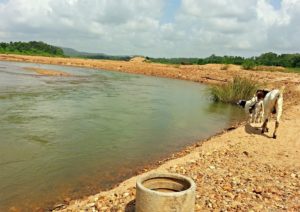 We started at around six in the morning from Kochi, had breakfast from Thrissur and reached Cheruthuruthi by 9 am where we caught the first glimpse of the Bharatapuzha. We stopped the car under the Cheruthuruthi bridge and walked down to the river. The river had been reduced to a stream, hardly 10 meters wide. But the water was pristine, clear and cold. We get down at the water and got immersed in the soft caressing and refreshing chillness of the river along with the taste of the salt mango pickle bought from a local shop. After half an hour of unwinding, we moved on to the next location. I collected a few pebbles polished over centuries, by the flowing water, from the belly of the river as a Souvenir.
We started at around six in the morning from Kochi, had breakfast from Thrissur and reached Cheruthuruthi by 9 am where we caught the first glimpse of the Bharatapuzha. We stopped the car under the Cheruthuruthi bridge and walked down to the river. The river had been reduced to a stream, hardly 10 meters wide. But the water was pristine, clear and cold. We get down at the water and got immersed in the soft caressing and refreshing chillness of the river along with the taste of the salt mango pickle bought from a local shop. After half an hour of unwinding, we moved on to the next location. I collected a few pebbles polished over centuries, by the flowing water, from the belly of the river as a Souvenir. Kerala Kalamandalam was only a mile away from the bridge, but we were unlucky since Sunday was an off day and visitors were not allowed.
Varikkaserry Mana
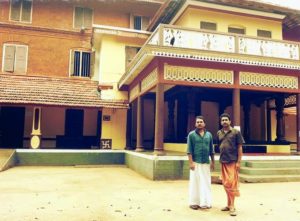
Our next stop was Varikkasery Mana, a well known Illam, that owes its present-day glory to the movie makers. The Mana was more than a century old and situated in the Manisseri Village which is 10 kilometers north of Cheruthuruthi, in Palakkad District. It was a traditional Nalukettu with Pathayappura (granary), Devi Temple and a large pond, all in the same compound. The richness of woodwork and the accurate application of geometry and measurements were awe inspiring. The Mana is an example of the strong tradition of Kerala in the field of Architecture.
We covered Shornur and Pattambi and continued our westward journey through the village roads running parallel to the Bharatapuzha. The roads were shaded by Gulmohar (Vaaka) trees on both sides. The road was bordered on one side by paddy fields and hills, the beautiful landscape of Valluvanadu. We forget hunger in the taste of the spicy buttermilk from Manissery and the sweetness of watermelon we had from Pattambi.
Thrithala, Kumbidi & Kuttipuram
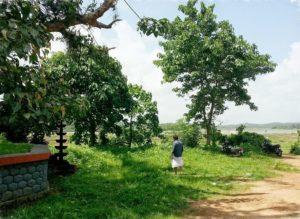 Our Next stop was Thrithala. The place was famous for the myths of ‘Parayi Petta Panthirukulam’. Mezhathol Agnihotri’s Vemancheri Illam and Pakkanar Memorial were situated here. There was a legend about the origin of the place name. Agnihotri had mixed the Thali in a plate (Thalam) in the shape of a Shivlingam while taking bath. After the bath, he observed that the thali was hardened, which is unnatural. He took this as an Omen and constructed a temple with the Shivlingam as the deity. This later became the famous Thrithala Siva Temple. The Thali + Thalam thus became the base of the place name ‘Thrithala’. The legend also says that the river had changed its course in respect to the deity. Whatever is the truth behind the story, the river does have a major bent here. We stopped the car near the banyan tree which is related to the Pakkanar Stories and watched in awe the river facing its silent death from there for a few moments.
Our Next stop was Thrithala. The place was famous for the myths of ‘Parayi Petta Panthirukulam’. Mezhathol Agnihotri’s Vemancheri Illam and Pakkanar Memorial were situated here. There was a legend about the origin of the place name. Agnihotri had mixed the Thali in a plate (Thalam) in the shape of a Shivlingam while taking bath. After the bath, he observed that the thali was hardened, which is unnatural. He took this as an Omen and constructed a temple with the Shivlingam as the deity. This later became the famous Thrithala Siva Temple. The Thali + Thalam thus became the base of the place name ‘Thrithala’. The legend also says that the river had changed its course in respect to the deity. Whatever is the truth behind the story, the river does have a major bent here. We stopped the car near the banyan tree which is related to the Pakkanar Stories and watched in awe the river facing its silent death from there for a few moments.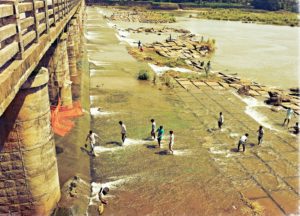 We entered the new regulator bridge at Velliyankallu. This small-scale irrigation project had helped in regaining the face and richness of the river at least for a few miles. The shutters were slightly opened at that time. The localites were catching fish beneath the bridge using techniques typical to countrysides.
We entered the new regulator bridge at Velliyankallu. This small-scale irrigation project had helped in regaining the face and richness of the river at least for a few miles. The shutters were slightly opened at that time. The localites were catching fish beneath the bridge using techniques typical to countrysides.We continued our journey via Kumbidi to Kuttipuram. The roads were rough, but the route is 5 kilometers shorter than its alternative path. We had seen a flock of cranes meditating for food in a paddy field. They flew away when I attempted to take photos. We reached Kuttippuram and entered the fourth district in the journey. We had already covered Ernakulam, Thrissur, and Palakkad before.
What we read and anticipated at Kuttipuram was a beautiful river charming like a young bride. But what we witnessed was the heartbreaking sight of a narrow stream and few potholes of water under the bridge.
Thirunavaya and Chamravattom
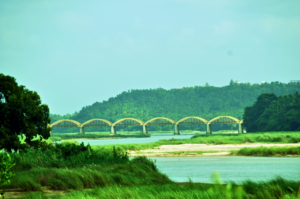 Nila Park is situated 2 kilometers away on the way to Thirunavaya. The place is good to spend some time with the family in the evenings. We continued our journey without stopping at the park. The quantity of water increased and the width of the river broadened as we approached Thirunavaya. This was due to the Regulator Bridge at Chamravattom. Nila was the beautiful princess as heard in the stories and folklores in this section.
Nila Park is situated 2 kilometers away on the way to Thirunavaya. The place is good to spend some time with the family in the evenings. We continued our journey without stopping at the park. The quantity of water increased and the width of the river broadened as we approached Thirunavaya. This was due to the Regulator Bridge at Chamravattom. Nila was the beautiful princess as heard in the stories and folklores in this section.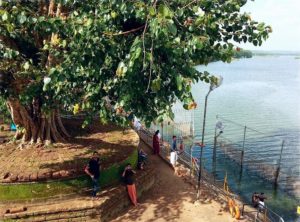
The ‘Nava Mukunda’ temple (Vishnu) in Thirnavaya on the bank of Nila is an old and famous temple. The temple is centuries old and many traditions and beliefs were there related to the temple. The Shiva and Brahma Temple on the other side of the river along with the Nava Mukunda Temple gave the aura of Trimoorthi Sangam for that section of the river. The Tharpanam in the Nava Mukunda Shore is considered as the most sacred one. Pilgrims from all over Kerala arrive here during ‘Vaavu Bali’ for the Rituals.
The biggest blessing that can happen in a journey will be the assistance of a local friend, who knows the place and culture well.
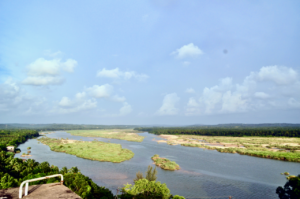
We were lucky at Thirunavaya, because of Jamsheer, an old teammate of Jose. He was friendly and was willing to guide us along the place.
Thirunavaya is famous not only for the pilgrimage but also for the bloody battles that happened in the past as well. It was on the same banks that the Mamankam Festival was once celebrated in every 12 years.
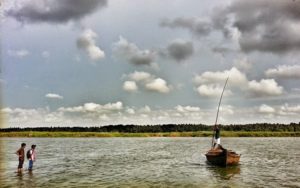 The tradition of suicide squads Valiant attempt to seize and kill the Zamorin (King) and there certain death facing the Kings Guards were a brutal tradition repeated every twelve years in those times. Jamsheer showed us the remains of this story, the Mani Kinar, Pazhukka Mandapam, Changampilli Kalari , NIlapaadu Thara etc.
The tradition of suicide squads Valiant attempt to seize and kill the Zamorin (King) and there certain death facing the Kings Guards were a brutal tradition repeated every twelve years in those times. Jamsheer showed us the remains of this story, the Mani Kinar, Pazhukka Mandapam, Changampilli Kalari , NIlapaadu Thara etc.
Jamsheer’s friend Ansar took us for a boat ride across the river. The catamaran ride amidst the sand islands and attuvanchi flowers was awe inspiring. Jamsheer took us to the school where he studied when we came back after the boat ride. The aerial view of the river from the top of the new water tank in the school was beautiful and yet disturbing.
Ponnani & the sunset
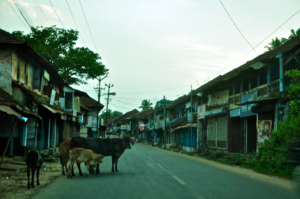 We were in a hurry to reach the last section of the river, Ponnani, before sunset. We quickly finished the Nombuthura Snacks offered at Jamsheer’s house, thanked the hospitality from the bottom of the heart and moved on to Ponnani. The lack of time made us skip the visit to ‘Thunjanparamabu’, the museum in memory of Ezhuthachan, the father of Malayalam Language. In 10 minutes we reached the Chamravattom Bridge, and get down there for taking photos. The bridge was inaugurated in 2012 which shortened the distance from Kochi to Kozhikode by 38 km. we took a few snaps and continued to Ponnani.
We were in a hurry to reach the last section of the river, Ponnani, before sunset. We quickly finished the Nombuthura Snacks offered at Jamsheer’s house, thanked the hospitality from the bottom of the heart and moved on to Ponnani. The lack of time made us skip the visit to ‘Thunjanparamabu’, the museum in memory of Ezhuthachan, the father of Malayalam Language. In 10 minutes we reached the Chamravattom Bridge, and get down there for taking photos. The bridge was inaugurated in 2012 which shortened the distance from Kochi to Kozhikode by 38 km. we took a few snaps and continued to Ponnani. We were only a few minutes away from sunset by the time we reached the Ponnani harbor. The harbor was deserted since it was an off day. Several seagoing boats were anchored there.
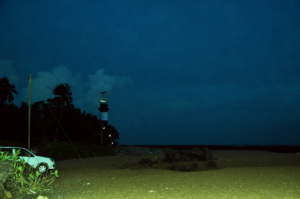
The lighthouse that witnessed the campaigns of Kunjali Marakkar and Battles of Samoothiri and Vettathu Nadu was patrolling the calm Lakshadweep sea with its lighted eye. In front of us was the silent and calm Nila ending her long journey in the sea. And as we were lost in the sight, the sun sets in the western horizon and darkness prevailed symbolizing the gloomy fate of the once mighty river.
We were tired, but satisfied, on our journey back to Kochi. After 208 kilometers drive and an eventful day, we felt relaxed and contained. We prayed silently for the river. May the god help her to regain her lost glory and bless the future generations too.
